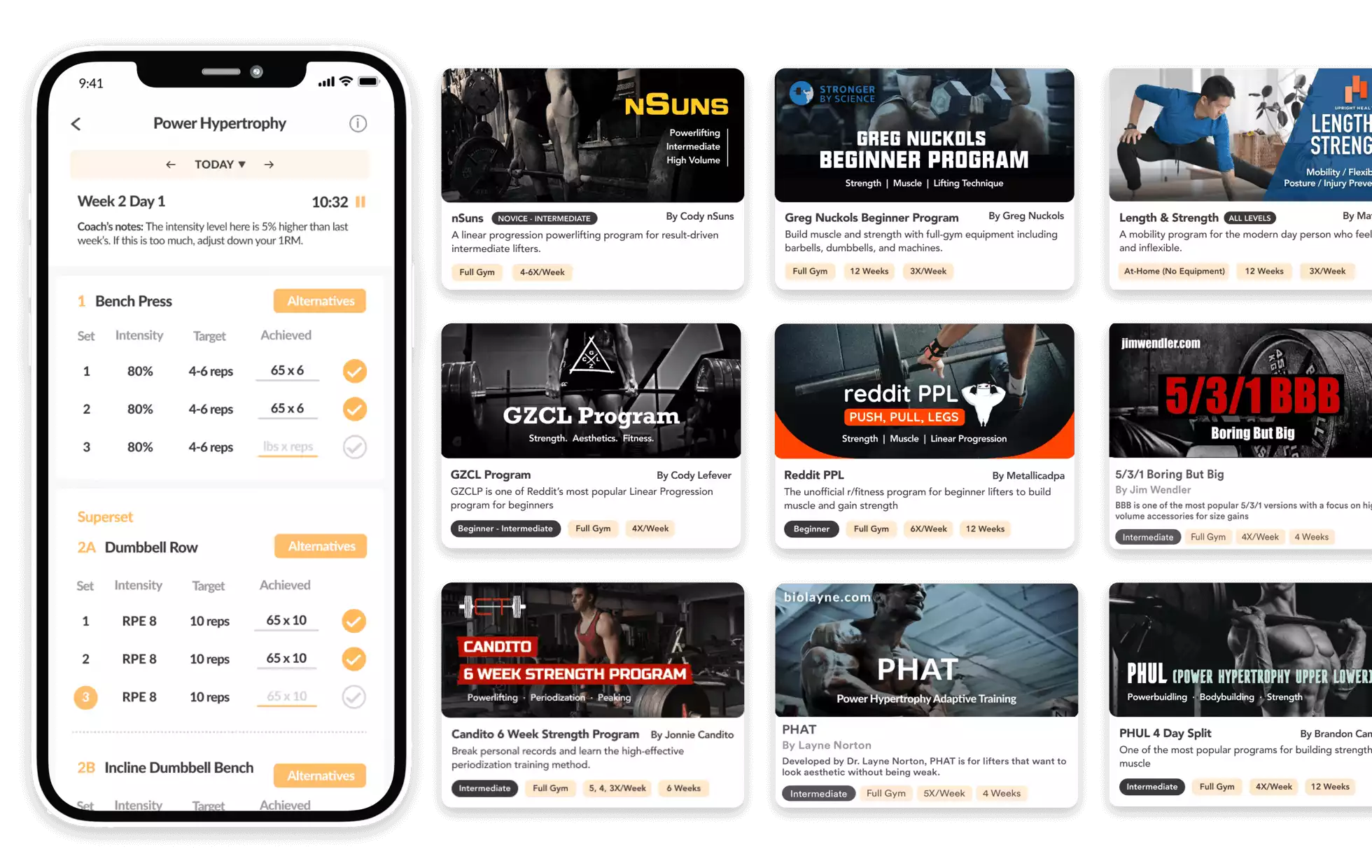Note: The below spreadsheet is based on the 2019 version of Mike Israetel’s articles on muscle group hypertrophy. As of March 2020, he is in the midst of updating these articles with new guidelines. These guidelines have not yet been taken into account in the spreadsheet, but an updated spreadsheet is in the works. For the latest thinking from Mike Israetel, please read the articles linked in this post. A second update will be posted here when the spreadsheet is updated.
Dr. Mike Israetel published a very popular article entitled Training Volume Landmarks for Rennaisance Periodization.
A summary of the article is below, though reading the article in its entirety is recommended.
Table of Contents
5 Week Hypertrophy Workout Routine Spreadsheet
A terrific Lift Vault reader submitted this spreadsheet to help provide more structure to the recommendations made by Mike Israetel in the article. It makes it much easier to use the workout based on your own current strength levels.
This is a 6 day hypertrophy workout routine that runs for a 4 week mesocycle and includes a deload on week 5.
Using the Spreadsheet
- There are some extremely important concepts about hypertrophy explained below. Please read them – or better yet, read Mike Israetel’s article in its entirety.
- Adjust your starting weights – use the calculator on the “Week 1” sheet if needed. Be conservative – there is lots of time to add weight and remember this is a hypertrophy program.
- The exercises are pulled from the various muscle group articles on Renaissance Periodization.
- The number of sets done each week is tracked on the “Sets per Week Summary” tab.
- Pro Tip: It’d probably be a good idea to track RPE or RIR for each exercise so you can look back on the mesocycle and see if the number of sets used was effective or not.
The hypertrophy spreadsheet is based on the principles discussed in the article, though the spreadsheet is in no way affiliated with Mike Israetel. It was constructed based on an interpretation of his training volume landmarks article. If you want real training advice directly from Renaissance Periodization, please see their coaching options.
 Boostcamp App
Boostcamp App
Many of the most popular programs on Lift Vault are now available on a free app!
Boostcamp lets you track progress, calculate weight/sets/reps, and discover new programs - all for free!
Understanding Hypertrophy Training Volume
In Dr. Israetel’s article, he discussed the following training volume topics:
- maintenance volume (MV)
- Maintenance volume is the number of sets needed to maintain your current muscular size.
- minimum effective volume (MEV)
- Minimum effective volume is the lowest number of sets needed to increase your muscular size.
- maximum adaptive volume (MAV)
- Maximum adaptive volume is the volume range where the most muscular growth occurs.
- maximum recoverable volume (MRV)
- Maximum recoverable volume is the upper limit of training volume that the body can still recover from (i.e. repair and grow muscle mass).
- Regular training in the MRV range will result in excessive accumulated fatigue and will not induce hypertrophy. Limited training near an athlete’s MRV prior to a deload can be effective for achieving super-compensation.
This allowed for a much more finely tuned hypertrophy-based workout depending on the muscle groups the athlete wanted to develop. It also allows for individual differences to be recognized, as different athletes will have different MV, MEV, MAV, and MRV.
It is important for a lifter to begin to identify these variables in for themself through training. If these variables are not currently understood, they can be learned through experimentation and observation.
How to Find Your Individual Optimal Training Volumes for Hypertrophy
Below are summaries of how to find different volume training landmarks for yourself. A full explanation is available in Dr. Israetel’s article.
Many of the below volumes reference “rep strength” or “performance.” Here is how this can be measured.
Performance or rep strength can be measured using RPE or reps in reserve. If during Week 1 of training you did 4 sets of 12 reps of bicep curls with 15 lb dumbbells and felt you had 2 reps in reserve at the end of your 4th set and then you repeated this weight*rep*set scheme at the end of a mesocycle and felt like you had 5 reps in reserve after the final set of curls – congratulations, you increased performance.
Similarly, if the last set during week 1 was RPE 8 and that same weight*rpe*set scheme was an RPE 6 on the test week after a mesocycle, performance was increased.
How to Find Your Maintenance Volume
- Two to three times per year should be spent doing maintenance training and eating to resensitize your body to stimulus and growth.
- Start by following the “MV” volume recommendations laid out in the article (also available on the “Sets per Week Summary” tab in the spreadsheet below).
- If your rep strength has been conserved at the end of one mesocycle at the prescribed volume, then the volume was adequate.
- Next mesocycle: try reducing the number of sets to see if your MV is even lower.
- If your rep strength declined, volume was too low and your MV is higher than the volume of work down in the previous mesocycle.
- Next mesocycle: increase the number of sets and see if rep strength can be conserved.
- General trip: be conservative. Your MV is probably lower than you think.
How to Find Your Minimum Effective Volume
Mike outlines two methods for calculating your minimum effective volume.
- Method 1: Start with recommended MEV (again, these are noted in the article as well as in the spreadsheet below on the “Sets per Week Summary” tab) and run for one mesocycle. Increase weights each week, but do not increase the number of sets. Test your performance on core exercises for each muscle group at the end of the mesocycle.
- If it improved, the volume of the last mesocycle was at or above your MEV. Try lowering volume by 2 sets each week and see if progress can continue to be made. Do this until you discover a volume that does not increase your performance. Add 2 sets to the volume that did not increase your performance and this is your approximate MEV.
- If your strength on a core exercise for a muscle group did not improve, the volume was below your MEV. Try adding 2 sets per week until performance improves.
- Method 2: To approximate whether a particular training session was within your MEV, ask the following questions.
- Did the training session provide a pump?
- No pump = 0 points
- Some pump = 1 point
- Great pump = 2 points
- Did the training session challenge the target muscles?
- No = 0 points
- Lots of tensions and fatigue = 1 point
- Muscles felt stressed and exhausted near their limit = 2 points
- Did the training session make you sore?
- No = 0 points
- Stiff for a few hours after or a little sore the next day = 1 point
- Sore for multiple days = 2 points
- Did the training session provide a pump?
- A score between 2 and 4 is likely to be within your MEV.
- If you’re training a muscle group 2x per week, expect more 4’s.
- If you’re training a muscle group 3-4x per week, expect more 3’s.
- If you’re training a muscle group 5-6x per week, expect more 2’s or even 1’s.
How to Find Your Maximum Adaptive Volume
Finding MAV is done by continually adding sets until soreness becomes excessive and peformance begins to degrade. Here is how to quantify excessive soreness and degrading performance.
- Soreness at the end of a session
- No soreness = 1 point
- A little stiff or sore afterward, but not sore at all by the time the next session for that muscle group occurred = 2 points
- Definitely getting DOMS (delayed onset muscle soreness), but it went away just in time for that muscle group’s next session = 3 points
- You got DOMS and were still feeling them during the next session = 4 points
- Performance during a session (this is modified from the article in an attempt to make it more usable)
- You had had 2+ reps in reserve, RPE 7 or lower = 1 point
- You had 1 rep in reserve, RPE 8 = 2 points
- You just barely got all the reps, RPE 9/9.5 = 3 points
- You missed reps or had performance degrade from last week (accounting for different weights, etc.) = 4 points
- How many sets to add based on points
- 1 + 1 = add 2 or 3 sets to that exercise
- Any 2’s = add 1 set to that exercise
- Any 3’s = do not add any sets to that exercise
- Any 4’s = consider taking a light session, half week, or full deload
